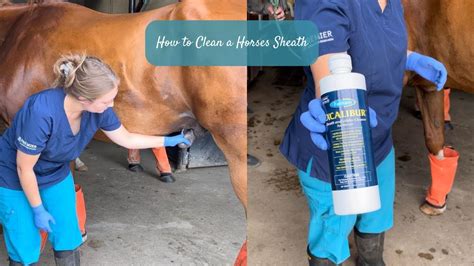How to Clean Your Horse's Sheath: A Simple Guide with Videos
Maintaining good hygiene for your horse is crucial for their overall health and well-being. One often overlooked, yet vital, aspect of equine hygiene is sheath cleaning. A neglected sheath can lead to infections, discomfort, and even more serious health problems. This comprehensive guide will walk you through the process of cleaning your horse's sheath safely and effectively. While we won't be providing direct video links (as per your instructions), we will describe the process in detail to allow you to easily find helpful videos online by searching for terms like "horse sheath cleaning tutorial" or "cleaning a horse's sheath."
Why is Sheath Cleaning Important?
The sheath, the protective covering of the penis in male horses (stallions, geldings), can accumulate smegma, a mixture of dead skin cells, oil, and other debris. This buildup can create an ideal environment for bacteria to thrive, leading to infections like balanitis (inflammation of the penis) or posthitis (inflammation of the sheath). Regular cleaning helps prevent these problems, ensuring your horse remains comfortable and healthy.
What You'll Need:
Before you begin, gather the necessary supplies. You'll need:
- Warm water: Use lukewarm water; avoid hot water as it can be uncomfortable for your horse.
- Mild soap: A veterinary-approved equine shampoo or a very mild, unscented liquid soap is ideal. Avoid harsh chemicals or strong scents. Some prefer to use just warm water.
- Clean cloths or sponges: Soft, absorbent cloths or sponges are best to avoid irritating the delicate skin. Have several on hand for changes.
- Gloves: Protect yourself from potential bacteria and smegma by wearing disposable gloves.
- Optional: Sheath cleaner: Some specialized sheath cleaners are available from veterinary suppliers. Always follow the manufacturer's instructions.
Step-by-Step Guide to Cleaning Your Horse's Sheath
Note: Always approach your horse calmly and confidently. If your horse is resistant, consult with a veterinarian or experienced equine handler.
-
Preparation: Ensure your horse is safely restrained in a manner that allows access to the sheath without causing undue stress or danger to either you or the horse. A stable cross-tie or a well-trained horse in a quiet environment is ideal.
-
External Cleaning: Gently wash the external area of the sheath with warm water and soap, paying attention to the opening. Rinse thoroughly.
-
Internal Cleaning (If Necessary): Many horses only require external cleaning, especially if the sheath is relatively clean. If significant buildup is present, carefully grasp the sheath (NOT the penis itself!) and gently retract the foreskin (the skin covering the penis). Using a fresh, clean cloth or sponge, gently wipe away the smegma.
-
Rinse Thoroughly: Once you have cleaned the visible areas, rinse the sheath thoroughly with clean warm water, ensuring all soap residue is removed.
-
Dry: Gently pat the area dry with a clean towel. Avoid rubbing aggressively.
Important Considerations:
- Frequency: The frequency of cleaning depends on your horse's individual needs and the amount of smegma buildup. Some horses may require cleaning weekly, while others might need it less frequently. Observe your horse regularly for any signs of irritation, odor, or discharge.
- Avoid Force: Never force anything into the sheath. Gentle pressure and wiping are all that are necessary. Be especially careful not to injure the penis.
- Signs of Infection: If you notice any swelling, redness, discharge, or foul odor, contact your veterinarian immediately. These could be signs of infection that requires professional treatment.
- Safety First: Always prioritize the safety of both yourself and your horse. If you're unsure about any aspect of this process, seek guidance from a veterinarian or experienced equine handler.
Troubleshooting Common Issues
H2: My horse is resisting the cleaning process. What should I do?
Some horses can be resistant to having their sheath cleaned. Patience and a calm approach are key. Use positive reinforcement techniques, such as offering treats or praise, to make the experience more positive for your horse. If the horse remains resistant, seek assistance from an experienced equine handler or your veterinarian.
H2: What are the signs of a sheath infection in a horse?
Signs of a sheath infection can include swelling of the sheath or penis, redness, a foul odor, and discharge (often purulent or bloody). If you observe any of these symptoms, it's crucial to contact your veterinarian promptly for appropriate diagnosis and treatment.
H2: How often should I clean my horse's sheath?
The frequency of cleaning depends on your horse's individual needs. Regular visual inspection is key. If you notice any buildup of smegma, it's time to clean it. In general, once a week is a good guideline but may vary for individual horses.
H2: Can I use regular soap to clean my horse's sheath?
While you can use a very mild, unscented liquid soap in a pinch, it’s always best to use a veterinary-approved equine shampoo or a specialized sheath cleaner. These are formulated to be gentler on the sensitive skin of the sheath and less likely to cause irritation.
By following these guidelines and watching relevant videos online, you can confidently and effectively maintain your horse's sheath hygiene, contributing significantly to their overall health and comfort. Remember to always consult your veterinarian if you have any concerns or notice any unusual symptoms.

